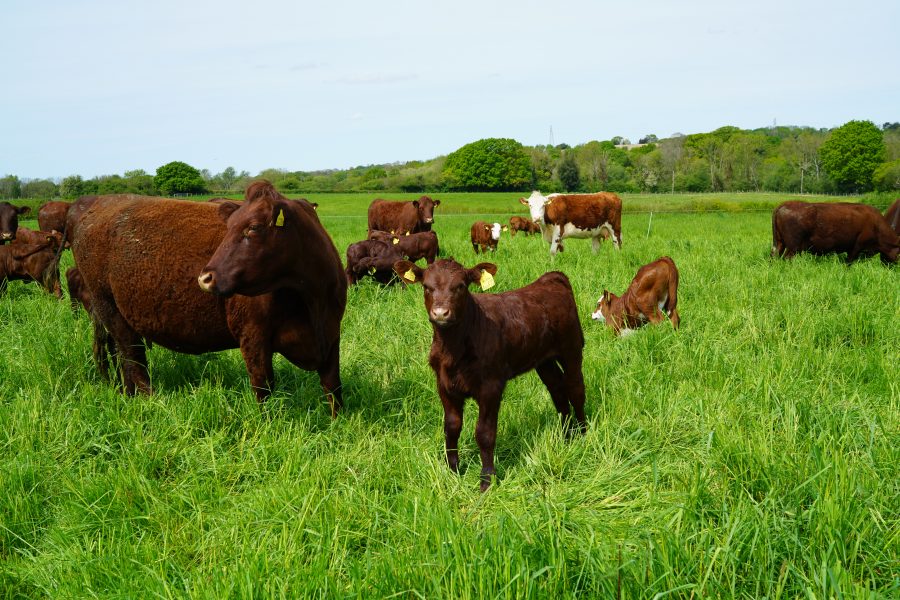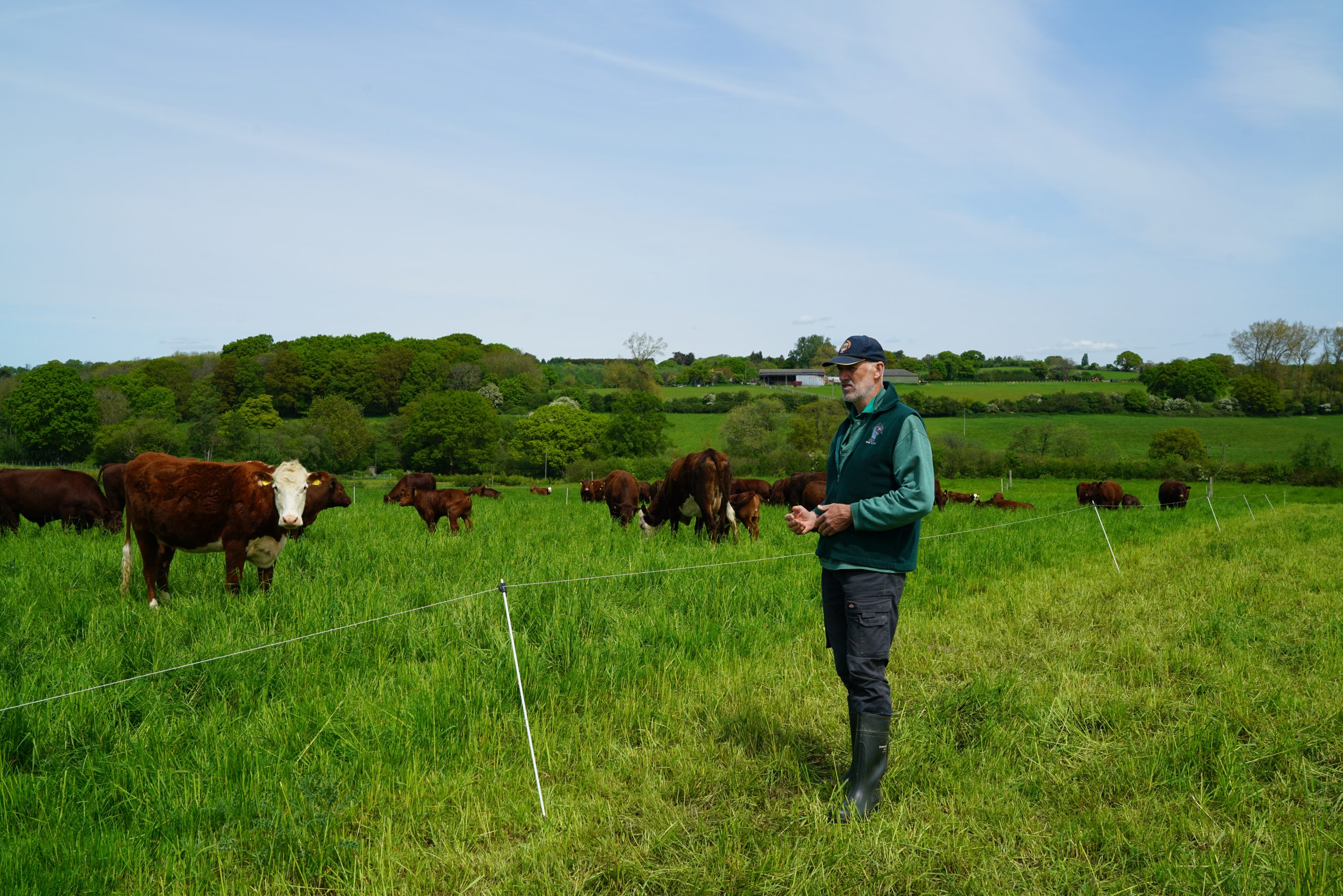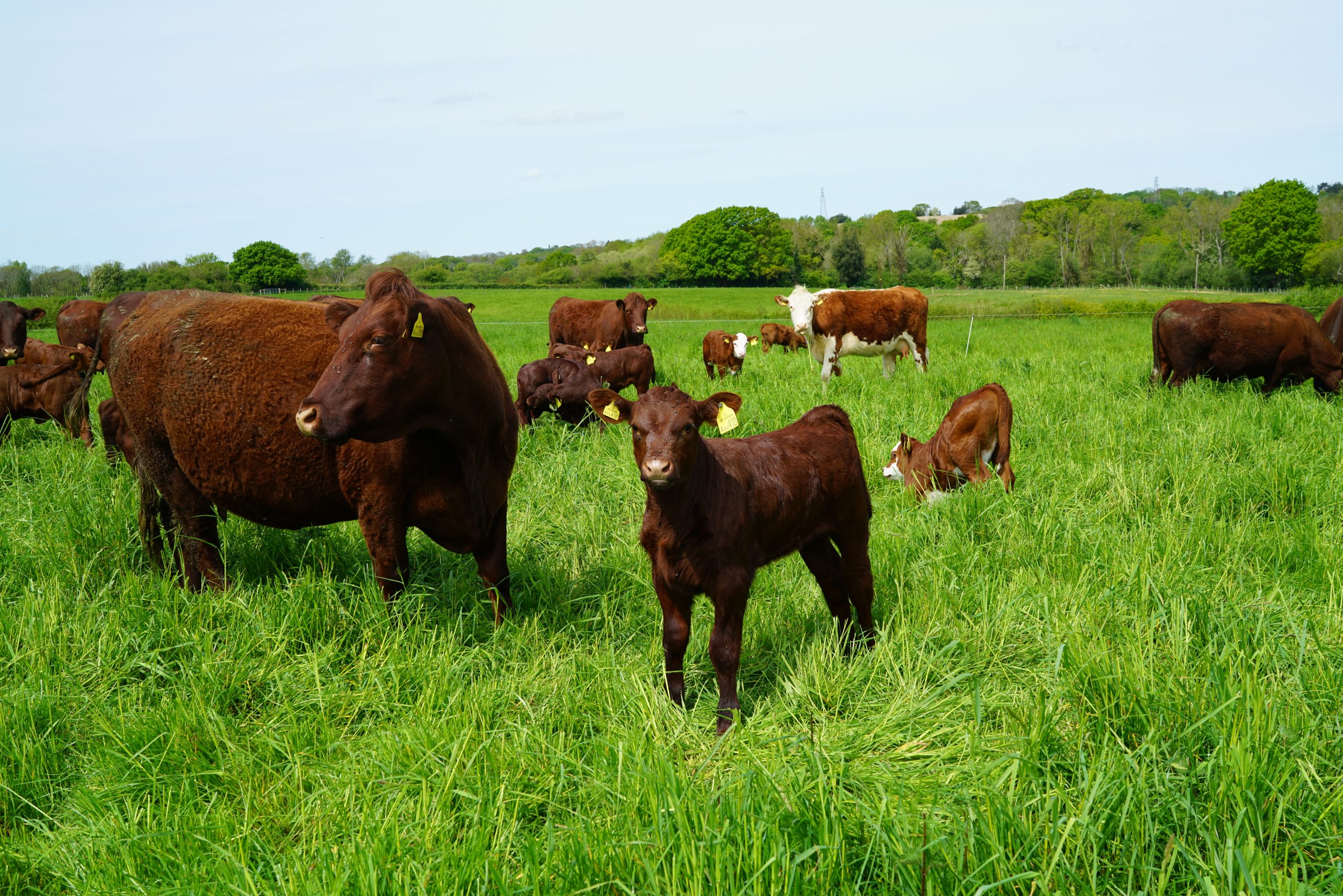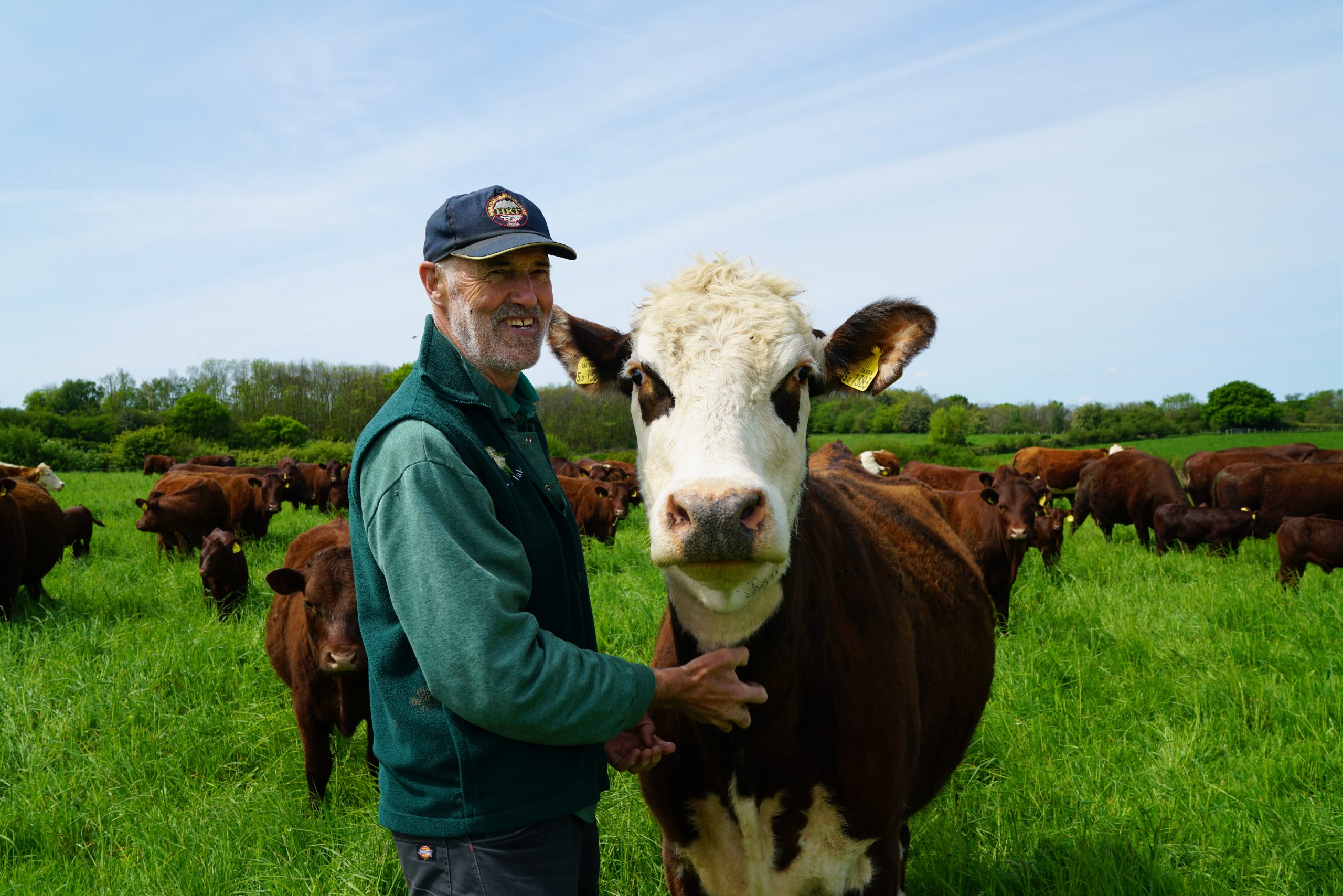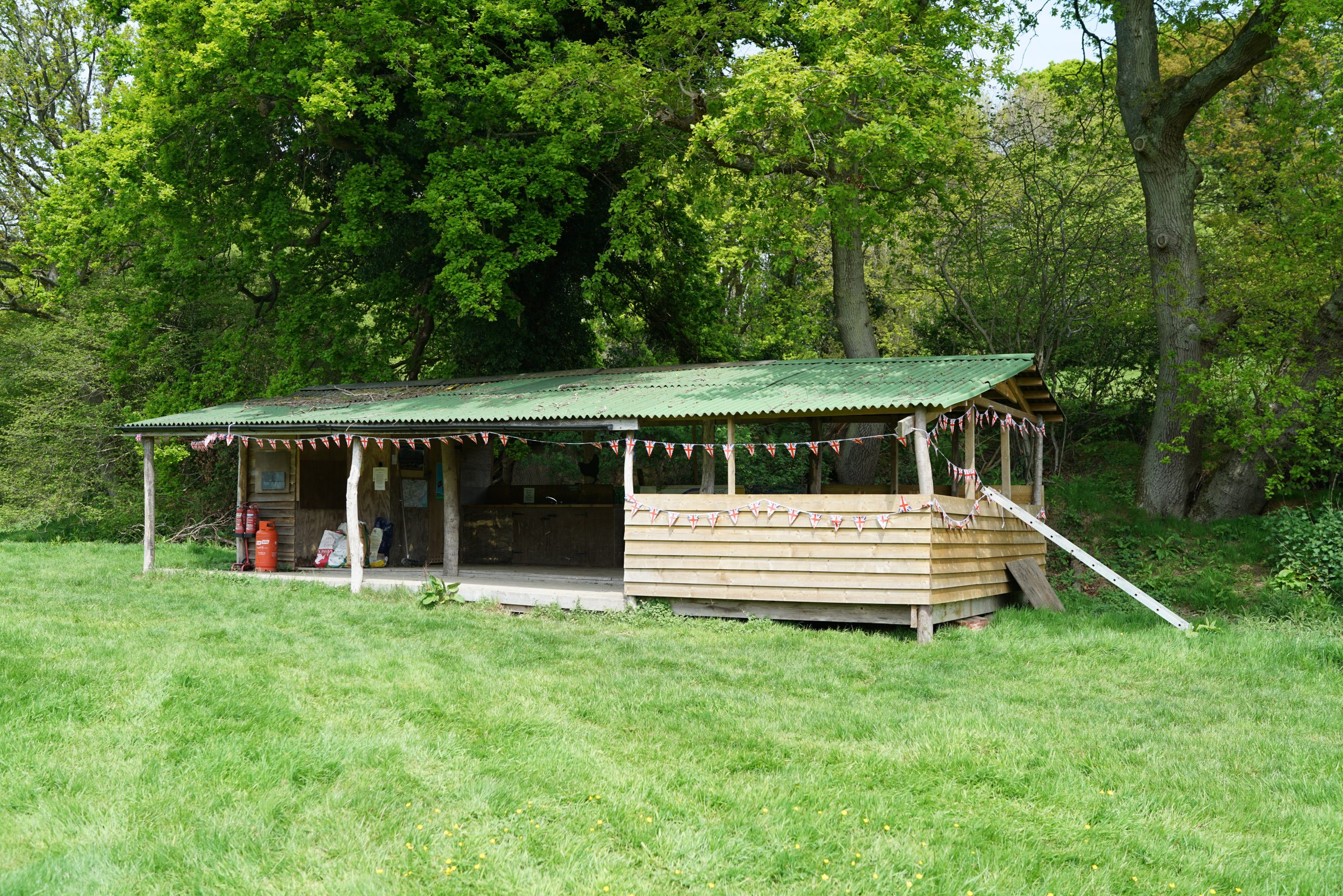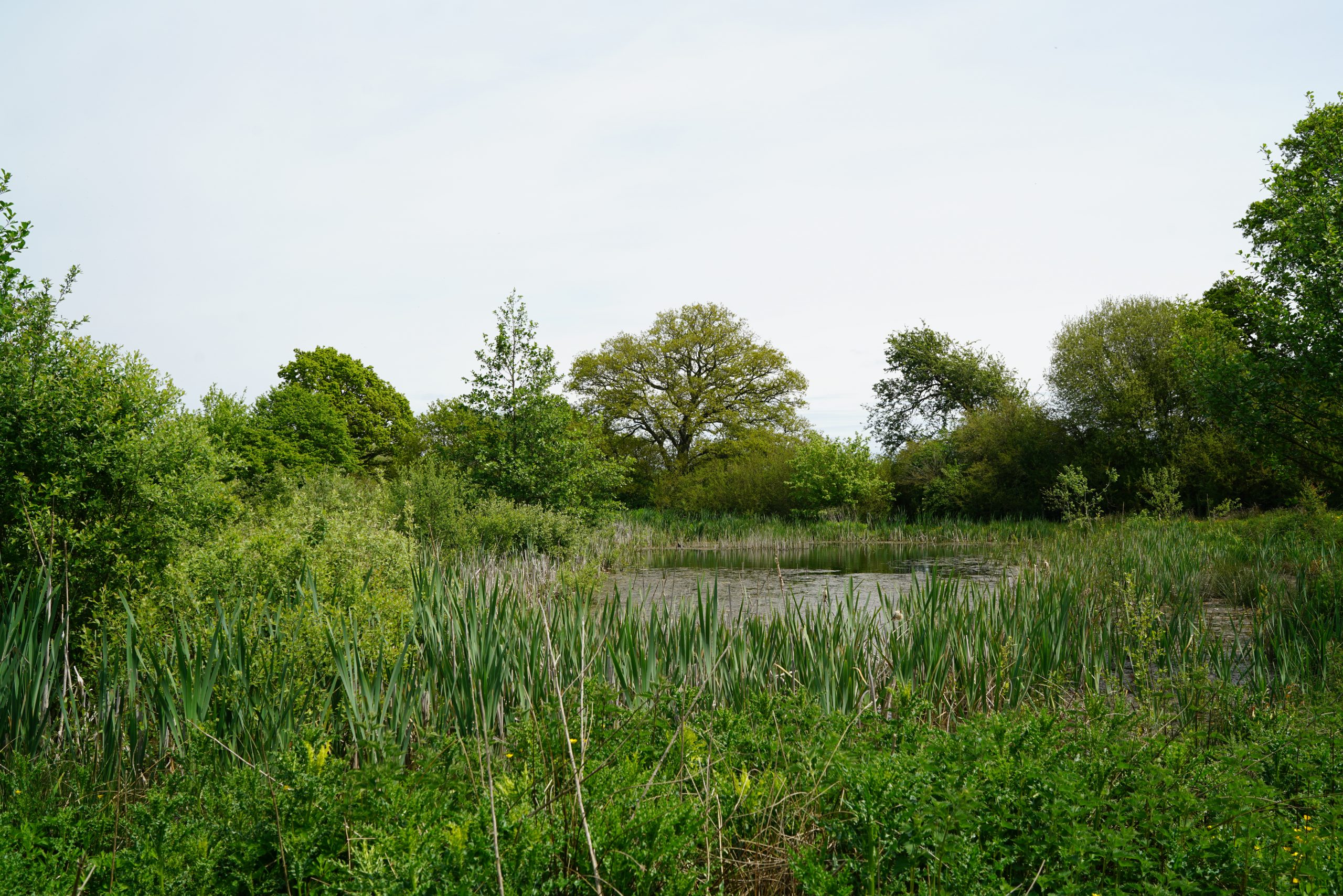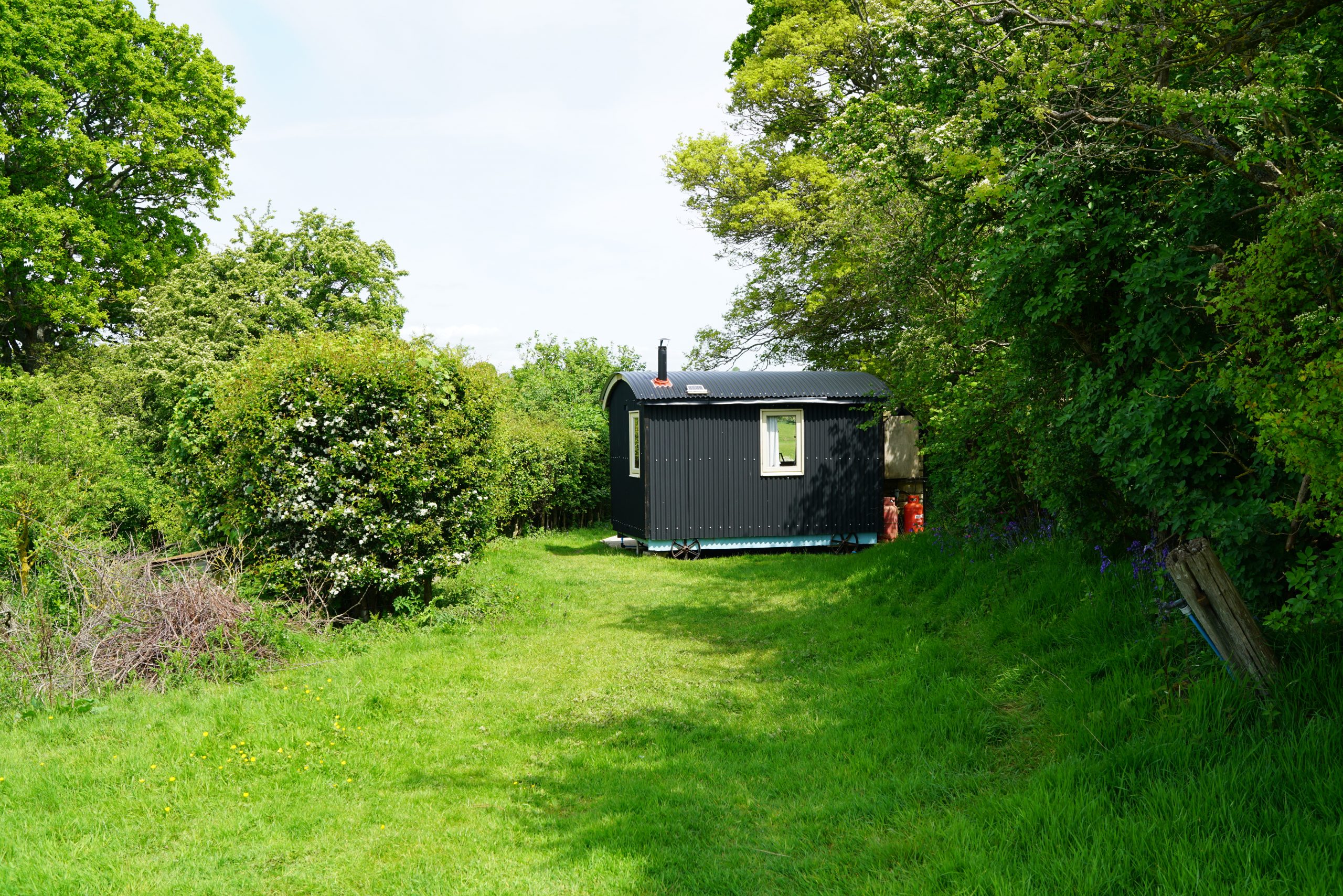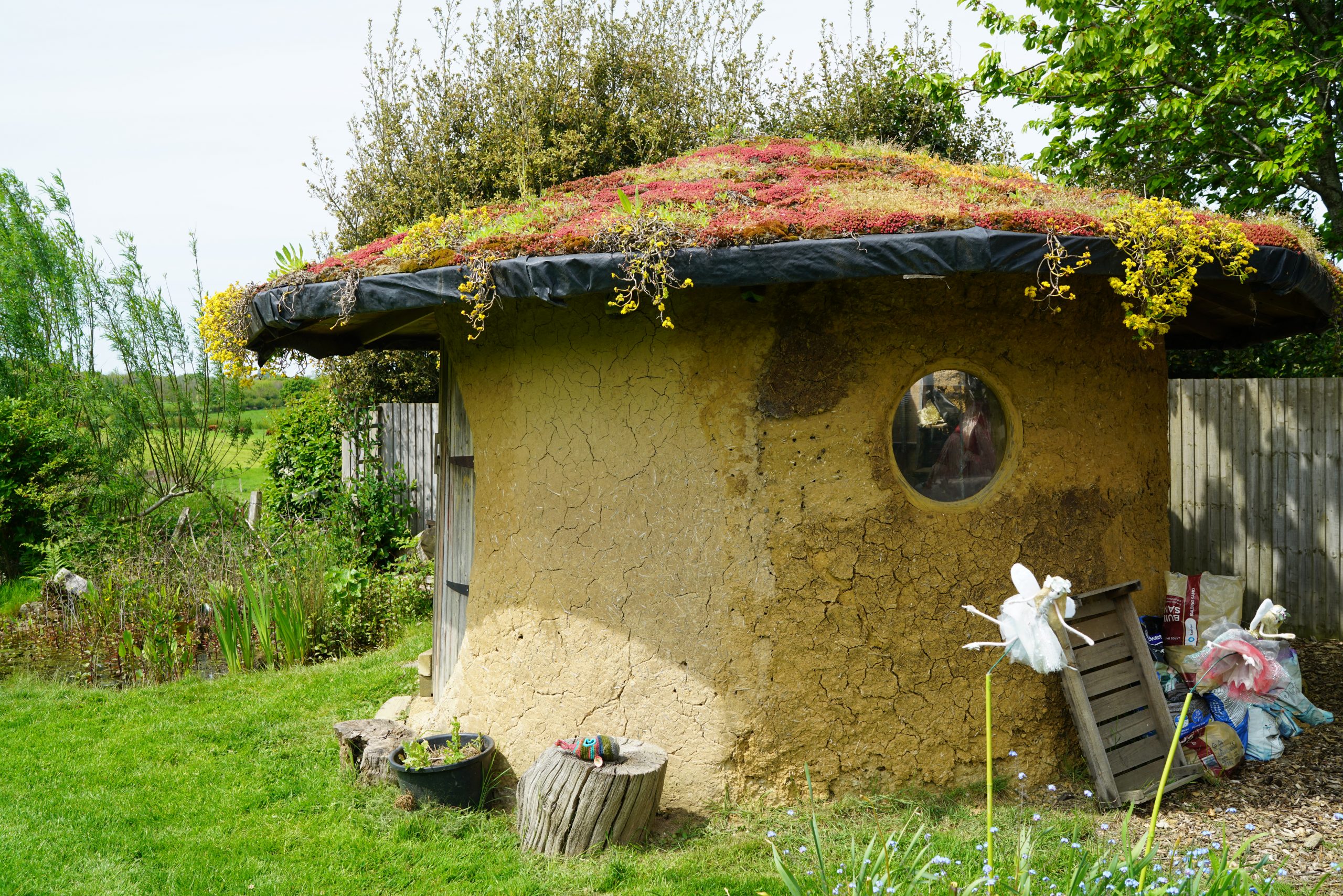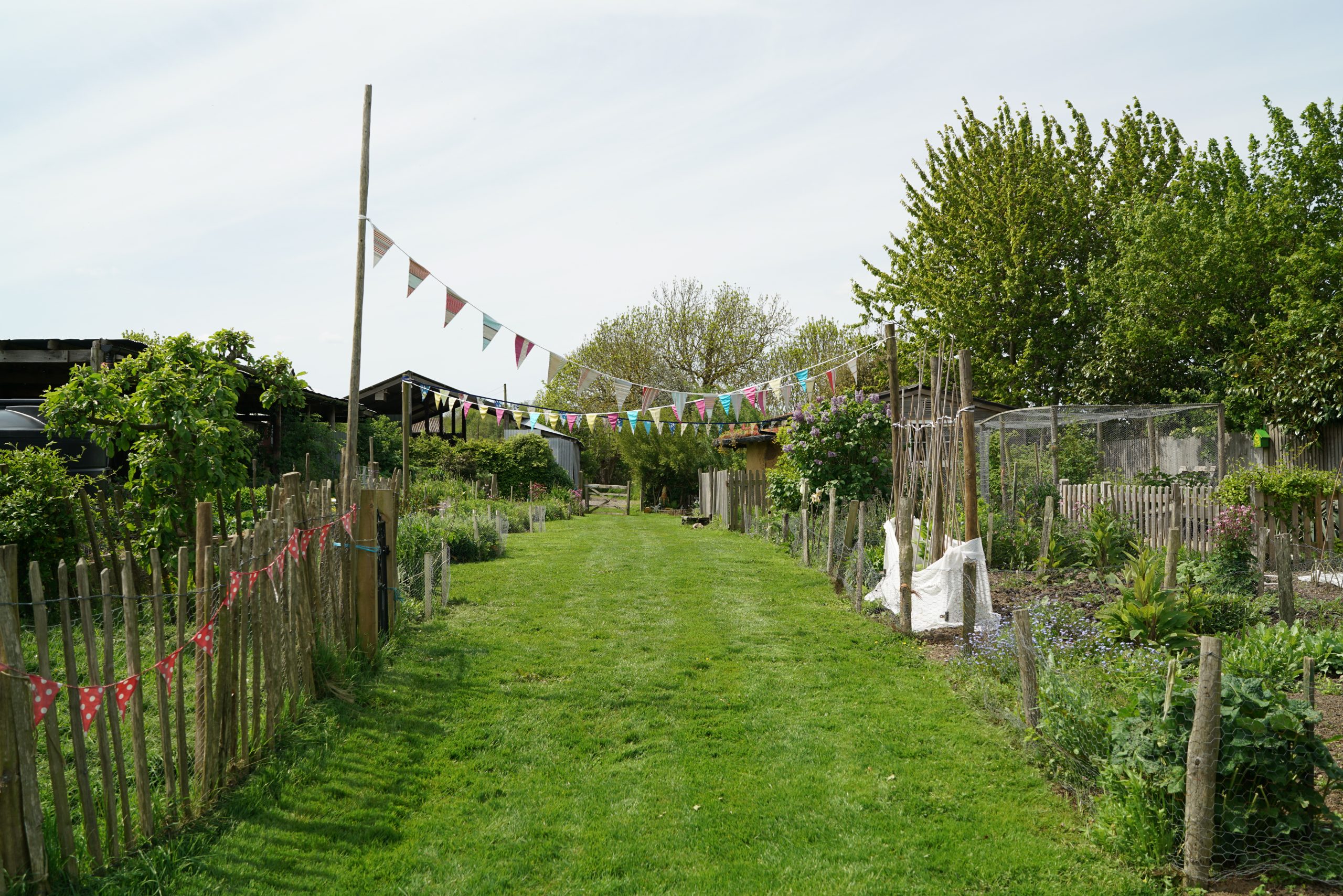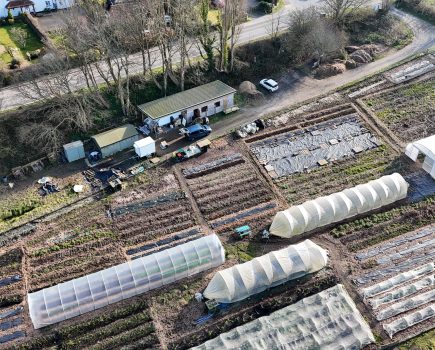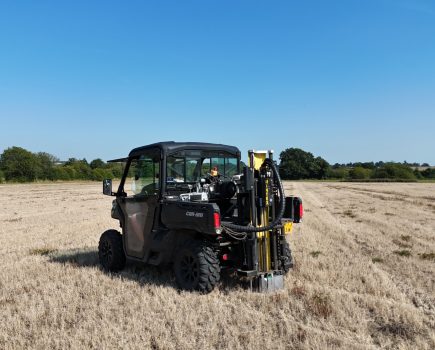This month Nigel Akehurst visits Pickham Farm, situated in the High Weald AONB in the village of Pett, near Hastings, East Sussex, to meet Farmer Tim Jury, a recent convert to mob grazing. He and his wife Anne also run a successful camping and glamping business on the farm.
Arriving at Pickham Farm, I meet farmer Tim Jury at his home, Freshwinds, located at the top of the farm drive. Before heading out for a tour of the farm, we sit down for chat over a coffee in the kitchen, with a view out onto his herd of Sussex cows and calves.
Like many farmers in the UK, Tim is well into his sixties and has spent all his working life farming. His grandparents, Henry and Janet Jury, originally took on the farm tenancy at Pickham in 1926, he explained, and it wasn’t until 1977 that he and his brother Nick were able to buy it. Around the same time, they decided to get out of dairy and increased the sheep flock and arable enterprises instead.
Tim preferred the sheep job and over the years built up a flock of 900 breeding ewes, renting additional grazing locally. They used every tool in the box and he can remember applying a bag of nitrogen a month (up to 50kg an acre between April to Oct) to keep seven ewes and their two lambs per acre.
Sheep farming was hard physical work, but he was able to make a decent living when everything went to plan, he said. Then in the early 2000s, with falling farm commodity prices, both Tim and his brother sought work outside the farm. After a few years a more permanent arrangement was found, with Nick finding a full-time job and Tim carrying on farming.
During that time Tim ran a herd of 30 continental sucklers and Will, one of Tim and Anne’s sons, tried selling meat boxes from a butchery on the farm, a farm diversification that ultimately didn’t work out, he said. It was after this that Will went out to Australia on an exchange programme working on a cotton and beef farm in New South Wales (NSW). Ultimately Will settled there, having fallen in love with his boss’s daughter; they now have a young family and farm on the Liverpool plains in NSW.
In 2011 Anne hit upon the idea of setting up a separate camping and glamping business on the farm as she wanted to find a way of retiring from her role as a community nurse. Freshwinds Camping was duly set up.
More recently Tim decided to scale back the livestock enterprise and tried letting some of his land for sheep grazing. “Everyone has different standards, but they weren’t very well looked after so the arrangement was ended,” he said.
After reading more about regenerative farming, he decided he wanted to try restoring the ecology of the farm. After discussing his options in a meeting with Christine Meadows from the High Weald AONB office in 2020, he decided that mob grazing cattle would be the best course of action.
Christine put him in touch with Kent-based mob grazier David Cornforth (featured in the July 2021 edition of South East Farmer) who became his mentor as part of the government-funded Pasture For Life (PFL) Pasture and Profit in Protected Landscapes scheme in 2022. Tim was hooked and the rest, as they say, is history.
Farm Tour
We headed out to see Tim’s cows and calves in the field next to the house. He explained how he divided up his fields with lanes of permanent electric fencing and installed lots of moveable poly pipe for his drag trough. He then sub-divides the lanes into paddocks with mobile electric fencing kit from Kiwitech.
He first started mob grazing his herd of 21 native breed cows and followers last spring. It’s early days, but he’s already noticed more diversity in his sward and even some of his old sheep-sick pasture (which he says still struggles) is beginning to recover a bit quicker.
At the time of visiting, everything looked very lush, with his mob of Sussex cows and calves happily grazing the long grass.
We stopped to take a few photos of Tim giving the matriarch of the herd a neck scratch and then he pointed to the previous day’s paddock that he had grazed too hard.
“In the beginning I read that the theory was you want the cattle to graze a third, trample a third and leave a third,” he said, though in practice and following his mentorship with David this is far from being rigid and can vary quite a bit depending on the weather conditions, time of year and whether he wants to open up the sward a little to allow different species to come through.
When you graze you put the plant under stress, he explained, which is why it’s important to rest the paddock for at least 60 days before grazing it again. This rest period is vital and what regenerative grazing is all about.
To prevent grazing re-growth, you need to move your cattle to a fresh paddock or cell at least every three to four days, advised Tim, although he recommends trying to move them daily or even thrice daily, which has been shown to get better results both in terms of grass productivity and soil health improvement.
He admitted a lot of his pasture is still very weed infested, with a lot of thistles, docks and nettles, but he hopes they will reduce under this system, as experienced by his mentor David Cornforth on his farm in Kent. By allowing the grass to compete with the weeds during the rest period they are less likely to take over and instead just become part of the diversity of the pasture, a good thing.
Another big advantage of mob grazing is reducing the winter housing requirement, said Tim. Typically cattle spend up to six months in a shed from October to April, but he has managed to keep them out most of the winter, bringing them in last winter for about five weeks. This, he points out, has reduced the need to buy in as much straw and cut down on the amount of hay and silage he needs to make.
He does bale graze round bales of hay in the field during the winter months, which he unrolls using a bale unroller designed by Martin Bradley and pulled behind his ATV, which he showed me in his farmyard.
Moving on, we walk down towards the camp site and pass one of the areas where he has planted trees. In 2018/19 he planted over 1,500 trees, creating new habitat and linking up existing hedgerows to create corridors for the farm’s thriving populations of wildlife, something both he and Anne are passionate about.
Tim also dug a pond in one of their wet fields and has recently started planting alleys of willow trees in his fields to provide shade for his mob grazing cattle, a tip he picked up from fellow mob grazier Sam Newington who farms nearby in Etchingham (we also featured Sam Newington in the July 2022 edition of South East Farmer).
Camping and glamping
We arrive at their secluded camp site at the bottom of the farm next to a small stream. The site had only just opened (they open from May to end of September), but bookings have been a little slow so far this year, said Tim.
They started the business, called Freshwinds camping, in 2011. It has evolved and grown over the years, but they are now seeing a lot more competition locally, said Tim. A good proportion of their bookings are now repeat customers, mainly families who love getting back to basics and who come every year, though they do list their site on a couple of booking sites, which helps bring in new customers.
With the Government currently looking into extending permitted development rights (PDR) for tent camping from 28 days to 60 days for farmers and landowners, the number of pop-up camp sites could increase significantly, I suggest?
He worries the sector is on the verge of being overdone and advises farmers considering it to “do your market research” before investing time and money in a camping project.
In addition to the camp site (which offer 15 pitches) the couple also has four luxury yurts and a shepherd’s hut, all separately located with their own outdoor kitchen, hot shower and compost loo. These units appeal more to couples and small families who want a few more creature comforts, said Tim.
Government policy and building a more sustainable food system
Heading back to the house I ask Tim what he thinks about the future of farming and government policy?
“A big part of the problem is we don’t pay the true cost of food,” replied Tim.
“In the 1950s we used to spend 50% of our income on food and now it’s less than 8%.”
He sees government policy as largely playing lip service and suggests that deep down they believe we can get food cheaper from abroad.
“We need to value food more and convince consumers to prioritise healthier options over cheaper, ultra-processed and highly profitable (for the retailer) foods. Regeneratively produced food is far more nutrient dense and many studies point to this being the answer to the nation’s health crises,” he said.
Tim sees the phasing out of BPS and transition to ELMS as a big opportunity to incentivise farmers to try more regenerative practices, and that doesn’t mean just cutting back on chemical inputs but phasing them out altogether.
On meat consumption Tim is in favour of eating less but better quality produce (native breeds, grass fed etc) but would also like to see more local produce available (both meat and vegetables) to consumers and support given to farmers to help them sell direct.
A bright future
Practicing regenerative farming has turned everything Tim thought he knew about farming on its head and given him a renewed lease of life, he said. After spending 45+ years as a conventional sheep, arable and beef farmer, he is now focused on restoring the biodiversity of the farm for future generations.
He also wants to help other farmers in the area make the transition to more regenerative practices. This year he has signed up to be a mentor for the PFL Pasture and Profit in Protected Landscapes scheme and is already helping two mentees.
With grants now available to help buy electric fencing and water kit and a growing community of farmers already doing it, Tim believes there’s never been a better time to give it a go. He recommends watching some YouTube videos to get a better understanding and joining PFL, which has lots of resources and gives access to a growing network of UK-based regenerative farmers.

